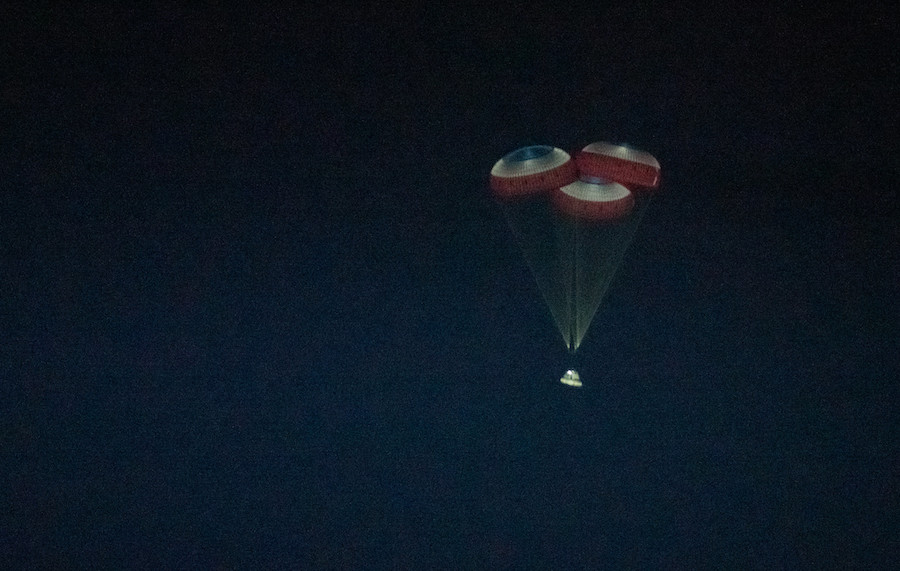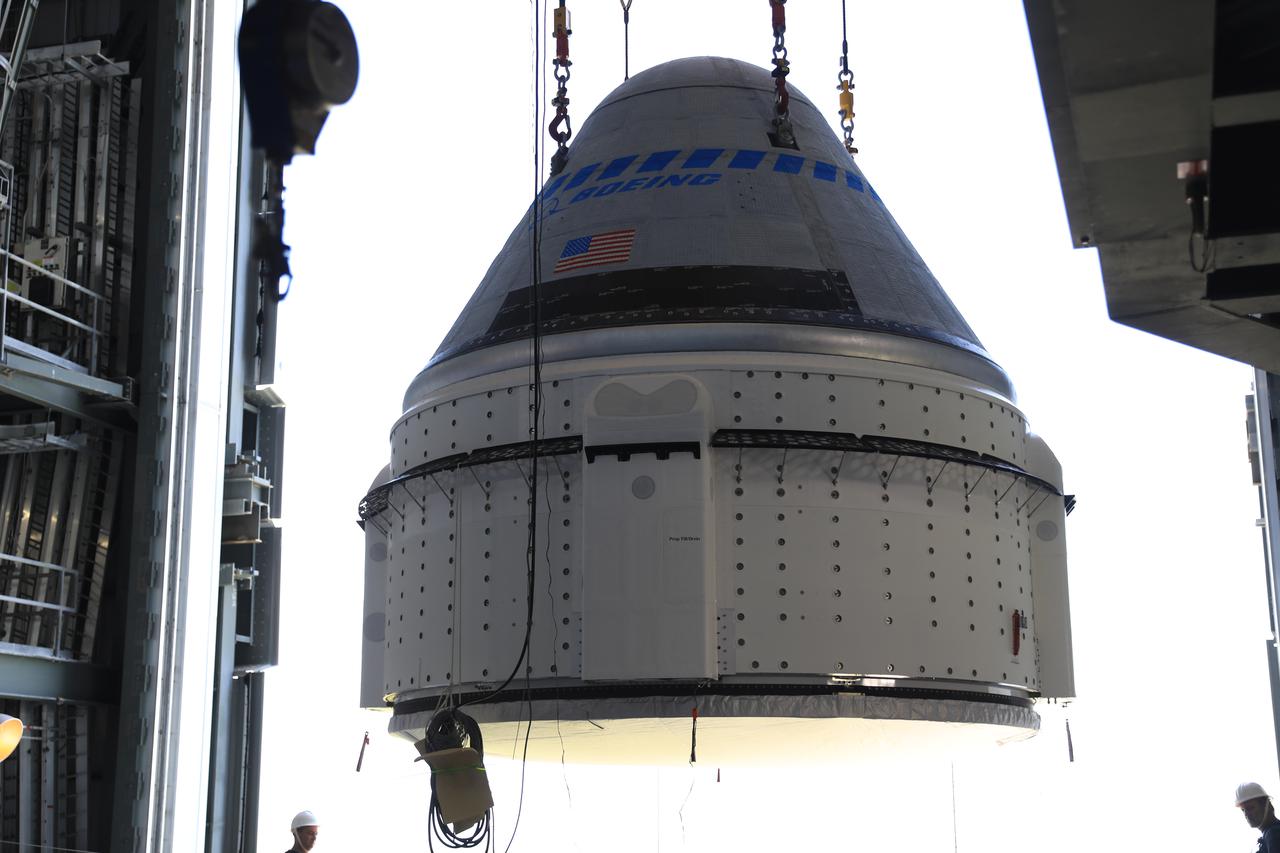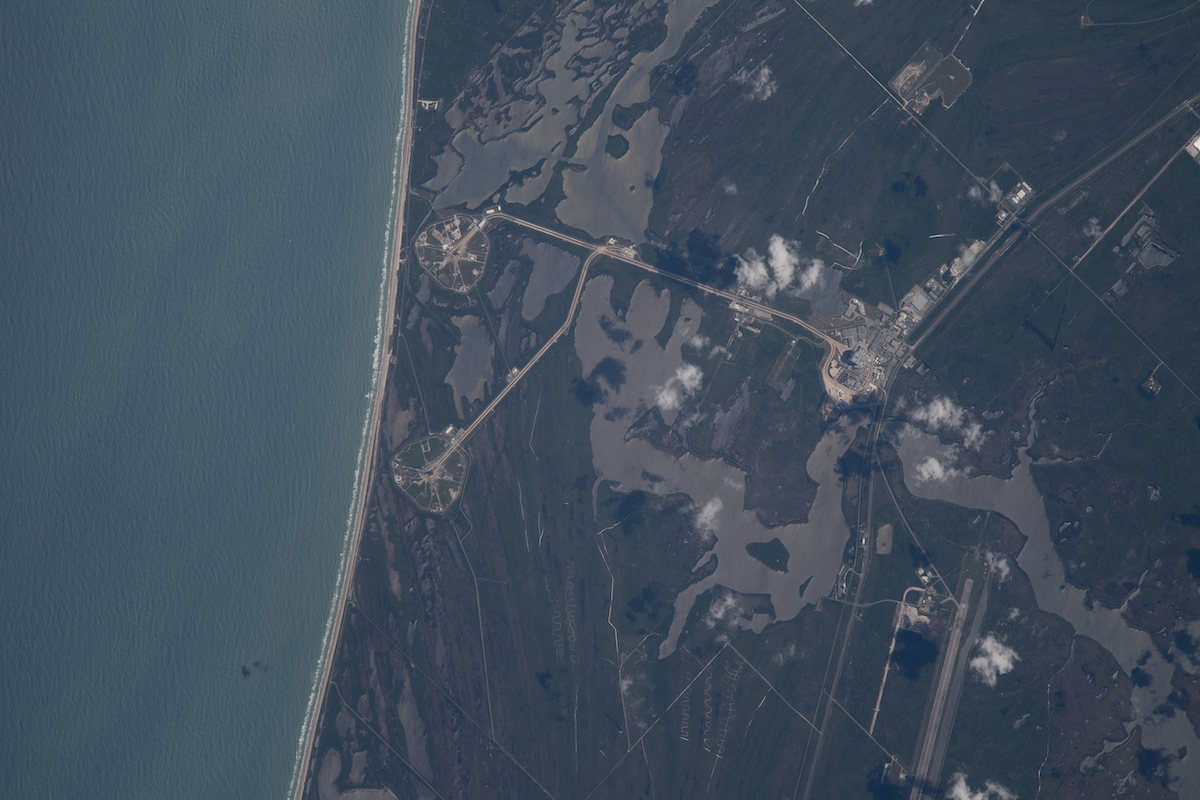Space News & Blog Articles
NASA safety advisors voice concerns over Boeing’s Starliner, SpaceX’s Starship
 Boeing’s Starliner spacecraft descends under parachutes on Dec. 22, 2019, at the conclusion of the Orbital Flight Test-1 mission. Credit: NASA/Aubrey Gemignani
Boeing’s Starliner spacecraft descends under parachutes on Dec. 22, 2019, at the conclusion of the Orbital Flight Test-1 mission. Credit: NASA/Aubrey Gemignani
Members of NASA’s independent safety advisory panel on Thursday cautioned the space agency not to rush toward a crew test flight of Boeing’s troubled Starliner spacecraft, and voiced concerns about final certification of the capsule’s parachutes and Boeing staffing levels on the program.
The safety advisors also said there are “obvious safety concerns” about SpaceX’s plan to launch the giant Starship rocket from pad 39A at the Kennedy Space Center, the same facility used for crew missions to the International Space Station.
Boeing plans to launch a redo of a problem-plagued test flight of its Starliner crew capsule next week. The mission — called Orbital Flight Test-2, or OFT-2 — will not carry astronauts. But if it goes well, the OFT-2 mission will pave the way for the next Starliner launch to ferry a crew to the space station for a final demonstration mission — called the Crew Flight Test, or CFT — before NASA and Boeing declare the new commercial vehicle ready for operations.
Developed in a public-private partnership, the Starliner spacecraft will give NASA a second human-rated capsule capable of ferrying astronauts to and from the space station, alongside SpaceX’s Dragon spaceship, which launched with a crew for the first time in May 2020.
With SpaceX now providing regular crew transportation services to the space station, NASA officials had time to wring out technical issues with the Starliner spacecraft. Nevertheless, NASA is eager to have two crew transportation providers to avoid again relying on Russia’s Soyuz spacecraft for astronaut flights in the event SpaceX runs into any significant delays.
“The panel is pleased that from all indications there is no sense of needing to rush to CFT,” said David West, a member of the Aerospace Safety Advisory Panel, in a public meeting Thursday. “The view that was consistently expressed to us (from NASA) is that the program will proceed to CFT when, and only when, they’re ready. Of course, the best path to CFT will be a successful OFT-2.”
NASA has signed a series of contracts with Boeing, valued at more than $5 billion, since 2010 for Starliner development, test flights, and operations. The contracts include agreements for six crew rotation flights to the space station — each with a four-person crew — following the completion of the OFT-2 mission and the shorter-duration Crew Flight Test with astronauts on-board.
But the Starliner program has faced years of delays. Software woes prevented the spacecraft from docking at the space station on the OFT-1 mission in 2019, forcing Boeing to put together a second unpiloted test flight at its own expense. The OFT-2 mission was on the launch pad last August, ready for liftoff on top of a United Launch Alliance Atlas 5 rocket, when engineers noticed 13 oxidizer isolation valves in the Starliner spacecraft’s propulsion system were stuck in the closed position.
After nine months of testing, investigations, and a swap to a new propulsion module, Boeing transferred the Starliner spacecraft back to ULA’s rocket hangar May 4 for lifting on top of an Atlas 5 rocket, ready for another go at launch. Read our previous story about the valve repairs.
West said Thursday that NASA managers have signed off on the oxidizer valve fix for the OFT-2 mission, but noted “there is some question as to whether a valve redesign will be required for future flights after OFT-2.” He also said managers approved “flight rationale” for issues with a high pressure latch valve on the Starliner command module propulsion system, a separate issue from the oxidizer valves in the service module.
 Boeing’s Starliner spacecraft is raised inside ULA’s Vertical Integration Facility on May 4 in preparation for the OFT-2 mission. The Starliner crew module is on top, and the service module is on bottom. Credit: NASA/Frank Michaux
Boeing’s Starliner spacecraft is raised inside ULA’s Vertical Integration Facility on May 4 in preparation for the OFT-2 mission. The Starliner crew module is on top, and the service module is on bottom. Credit: NASA/Frank Michaux
“Also, there’s concern that the certification of Boeing parachutes is lagging behind,” West said.
He also noted a “significant programmatic concern” with the limited number of human-rated Atlas 5 rockets remaining in ULA’s inventory. ULA has 24 more Atlas 5 rockets to fly before retiring the rocket in favor of the less expensive, more powerful Vulcan Centaur rocket.
Eight of those 24 rockets are already allocated to the Starliner program, enough to fulfill Boeing’s contractual requirement to NASA, which includes two more test flights and six operational crew rotation missions to the space station.
ULA’s new Vulcan rocket has not yet flown.
“Another factor is that the Vulcan launch vehicle slated to replace the Atlas 5 for Starliner launches needs to be certified for human spaceflight, and the process of getting that certification could take years,” West said.
West, a longtime engineering safety manager and examinations director at the Board of Certified Safety Professionals, said general concerns about the NASA and contractors workforce across the agency’s human spaceflight program have “particular significance in Boeing’s case.
“The panel has noted that Boeing staffing levels seem to be especially low,” West said. “The panel will be monitoring the situation in the near future to see what impact if any this could have on the existence or mitigation of any safety risks.
“While we don’t want to see and undue rushing toward the CFT launch, Boeing should ensure that all available resources are applied to meet a reasonable schedule and avoid unnecessary delays,” West sad.
“We are certainly behind the idea of not launching until (it) is ready, until all safety has been taken care of,” said Mark Sirangelo, another member of the safety panel. “At the same time, if the delays are caused by a lack of resources being applied to the program, that has significant impacts, or may have significant effects, to the NASA schedule for its return to the moon and many other things that are going to fan out from those delays.”
NASA and Boeing officials have declined to set a target schedule for the Crew Flight Test, only saying that preparations on the capsule for the first astronaut mission were on track to have the vehicle ready for launch by the end of this year. The schedule for the Crew Flight Test will largely hinge on the outcome of the OFT-2 mission.
 An astronaut on the International Space Station took this picture March 30 of the Kennedy Space Center, showing pad 39B at lower right, pad 39A just above it, and the Vehicle Assembly Building. North is down in this photo. Credit: NASA
An astronaut on the International Space Station took this picture March 30 of the Kennedy Space Center, showing pad 39B at lower right, pad 39A just above it, and the Vehicle Assembly Building. North is down in this photo. Credit: NASA
SpaceX, NASA’s other commercial crew contractor, has accomplished five crew launches for NASA, plus two all-private astronaut missions using the company’s fleet of Dragon spacecraft.
Officials said last year that SpaceX would end production of new Dragon capsules after building four human-rated vehicles. The fourth and newest member of the fleet launched for the first time last month. Each Dragon spacecraft is designed for at least five flights, and SpaceX and NASA could certify the capsule for additional missions.
“We are definitely concerned about whether requirements for transporting astronauts to and from the ISS through its remaining life, whatever that is, can be met without any additional Dragons,” West said. “It would be advisable to conduct parametric studies to inform and support relevant decisions about whether more Dragon capsules are required.
“The Dragon launch rate continues, however, and measures are being taken to keep the launch rate up,” West said. “Some of these measures may include deferring preventive maintenance and reusing Dragon several times. “The panel will be watching closely to see if these measures can be implemented without increasing risk.
“‘It should be noted, by the way, that there’s a huge amount of data coming from all these SpaceX launches,” West said. “While the data can benefit NASA, we think the care needs to be taken to keep from becoming overwhelmed by too much data.”
In February, NASA ordered three more crew rotation missions from SpaceX, adding to the six flights on the original commercial crew contract. Once Starliner is operational, NASA wants to alternate crew rotations every six months between Boeing and SpaceX, giving each provider one NASA astronaut flight per year.
West added that SpaceX plans to eventually launch the huge next-generation Starship rocket, currently under development in South Texas, from the Kennedy Space Center could pose a risk to the Falcon 9 and Dragon launch facility at pad 39A.
“One possible option that has been identified for launching Starship is from a planned new facility within the physical boundaries around pad 39A at the Kennedy Space Center, where Dragons are launched from,” West said. “There are obvious safety concerns about launching the large, and as yet unproven, Starship in such close proximity, reportedly only 300 yards or so, from another pad, let alone the path so vitally necessary for the commercial crew program.”
Pad 39A is also the only launch facility currently capable of launching SpaceX’s Falcon Heavy rocket, necessary to haul some heavier NASA and U.S. military spacecraft into orbit.
The Starship and its gigantic Super Heavy booster stage combine to stand nearly 400 feet (120 meters) tall. The system is designed to be fully reusable, and SpaceX plans to vertically land the Starship booster and upper stage back at the launch site.
SpaceX is finishing work on a Starship launch pad in South Texas, but the Federal Aviation Administration is reviewing the environmental impacts of SpaceX’s operations at the site before issuing a commercial launch license for the first full-up Starship orbital test flight.
NASA awarded SpaceX a $2.9 billion contract last year to develop a version of the Starship vehicle to land astronauts on the moon.
“In conclusion, I’d just like to say that these are extremely complex times for CCP,” West said, referring to NASA’s commercial crew program. “As the Starship launch site issued demonstrates, there are numerous external but related considerations to be made. One thing that continues to be clear, though, is that it’s still very important to reach the point where NASA has two viable CCP providers.”
This email address is being protected from spambots. You need JavaScript enabled to view it. the author.
Follow Stephen Clark on Twitter: @StephenClark1.
When you subscribe to the SpaceZE News Feed, we will send you an e-mail when there are new updates on the site so you wouldn't miss them.

